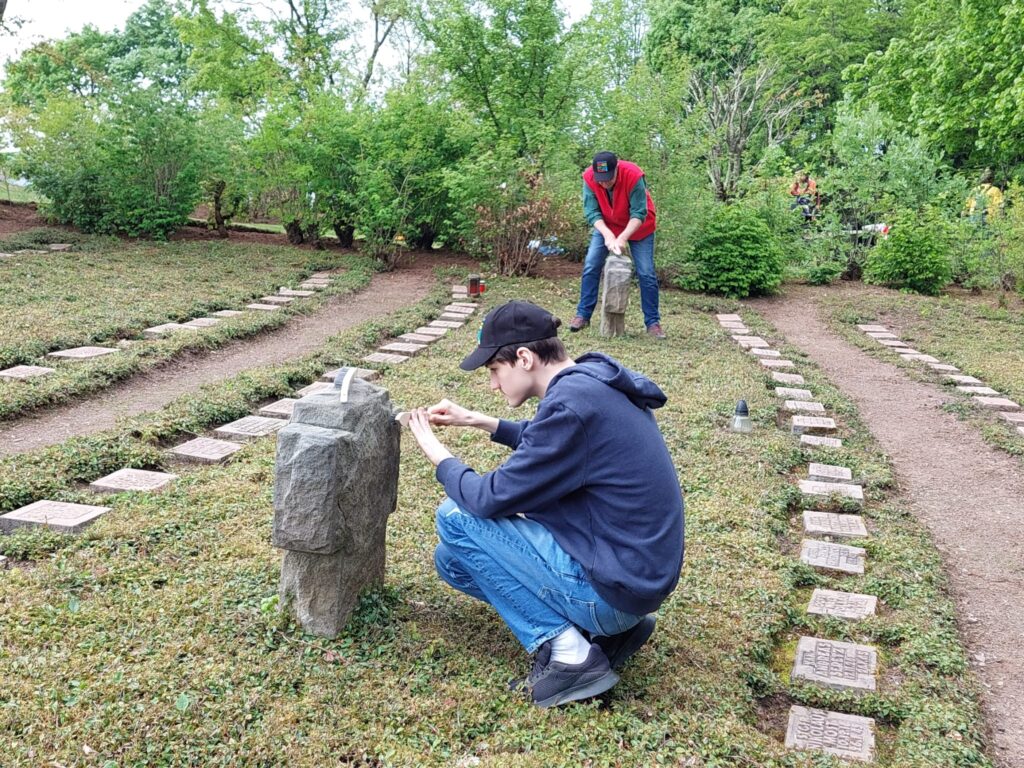
“I will never forget this school trip!”
This is how one pupil from the vocational preparation year class assessed the four days in which the class was on a school trip or work assignment in the West Eifel region near the Luxembourg border.
After several hours of driving to the small village of Daleiden, we moved into the local youth center. This is a community-owned self-catering house with newly renovated sanitary facilities and a fully equipped professional kitchen.
Daleiden is located 7 km east of the Luxembourg border in the middle of the scenic West Eifel region and has the largest military cemetery in Rhineland-Palatinate with over 3,000 military graves next to the town center. The latter was the reason why the class visited this inconspicuous climatic health resort. After arriving, the first step was to set up the accommodation, chop wood for the evening campfires and prepare the meals that were to be cooked over the following days. Under the guidance of the practical and class teacher Katrin Birmanns, the most fantastic simple dishes took shape, which were eaten with much appetite and chatter.
The evenings were filled with sitting around the campfire, bowling at the in-house bowling alley and lots of conversations about God and the world and about the exciting and challenging work that lay ahead at the cemetery of honor.

In cooperation with the German War Graves Commission, represented by Mr. Köppl, and with material support from the Remembrance and Peace Foundation, the class was to spend a day at the military cemetery doing maintenance work to preserve this dignified burial site.
Mr. Köppl prepared the class for this special place of history, remembrance and reminder for peace by walking with the class to various points in the cemetery and explaining the fates and backgrounds of the fallen, missing and unknown buried at individual graves.
The Daleiden war cemetery contains graves that fell in the Eifel-Ardennes region during the Second World War. Until they were reburied, the graves were spread across 72 smaller cemeteries in the region and brought together in Daleiden until 1959. As the site is located on a slight slope, the cemetery consists of several circular rows, which are connected by paths. The graves are all aligned towards a central focal point. This is where the memorial is located, which consists of a rotunda with a stone Pietà in the middle. Adjacent to the rotunda is a memorial hall with the names of the fallen buried there. The large number of names and the age of the fallen, which can be seen on the gravestones, impressed the pupils greatly, especially as many of the fallen were barely older than themselves.
Daleiden is located 7 km east of the Luxembourg border in the middle of the scenic West Eifel region and has the largest military cemetery in Rhineland-Palatinate with over 3,000 military graves next to the town center. The latter was the reason why the class visited this inconspicuous climatic health resort. After arriving, the first step was to set up the accommodation, chop wood for the evening campfires and prepare the meals that were to be cooked over the following days. Under the guidance of the practical and class teacher Katrin Birmanns, the most fantastic simple dishes took shape, which were eaten with much appetite and chatter.
The evenings were filled with sitting around the campfire, bowling at the in-house bowling alley and lots of conversations about God and the world and about the exciting and challenging work that lay ahead at the cemetery of honor.

The pupils were asked to help maintain, clean and repair the site. There were a number of grave slabs that were so badly weathered that they had to be replaced with new ones, moss and lichen had to be removed from many parts of the enclosure wall, as well as from large stone crosses that stood between the graves. As the cemetery is also a place for bereaved people who come to visit, benches also had to be repainted and made weatherproof. Ms. Lütke, who has been commissioned by the state of Rhineland-Palatinate to look after the graves, was on hand with help and advice and, like Mr. Köppl, answered many of the pupils’ questions about what was going through their minds as they worked on and looked at the graves. Some of them found it difficult to look after the graves, and the trepidation and sadness over the loss of a loved one and the countless sacrifices of very young soldiers lent the day a special atmosphere.

It was a busy day and so it was a little quieter than usual at dinner and later on. Nevertheless, there was a good feeling of having done something meaningful together, of having left behind a place of dignity and peace, where a candle against forgetting and for remembering now burned for each of the pupils on the new gravestones.
The next day was all about enjoying life and experiencing Europe together, as a trip to the city of Luxembourg was on the agenda. A completely new experience was made there with an exotic national language and lively city life.
And then it was time to say goodbye. On the last evening, the campfire was even more beautiful and more enduring than the days before. There were dances from the students’ different countries of origin and lots of music to sing or at least hum along to.
One thing the students said they had realized in Daleiden: no matter how different we are, we can trust that we somehow understand each other. We are sure that we will not wage a war that will cost so many lives.
